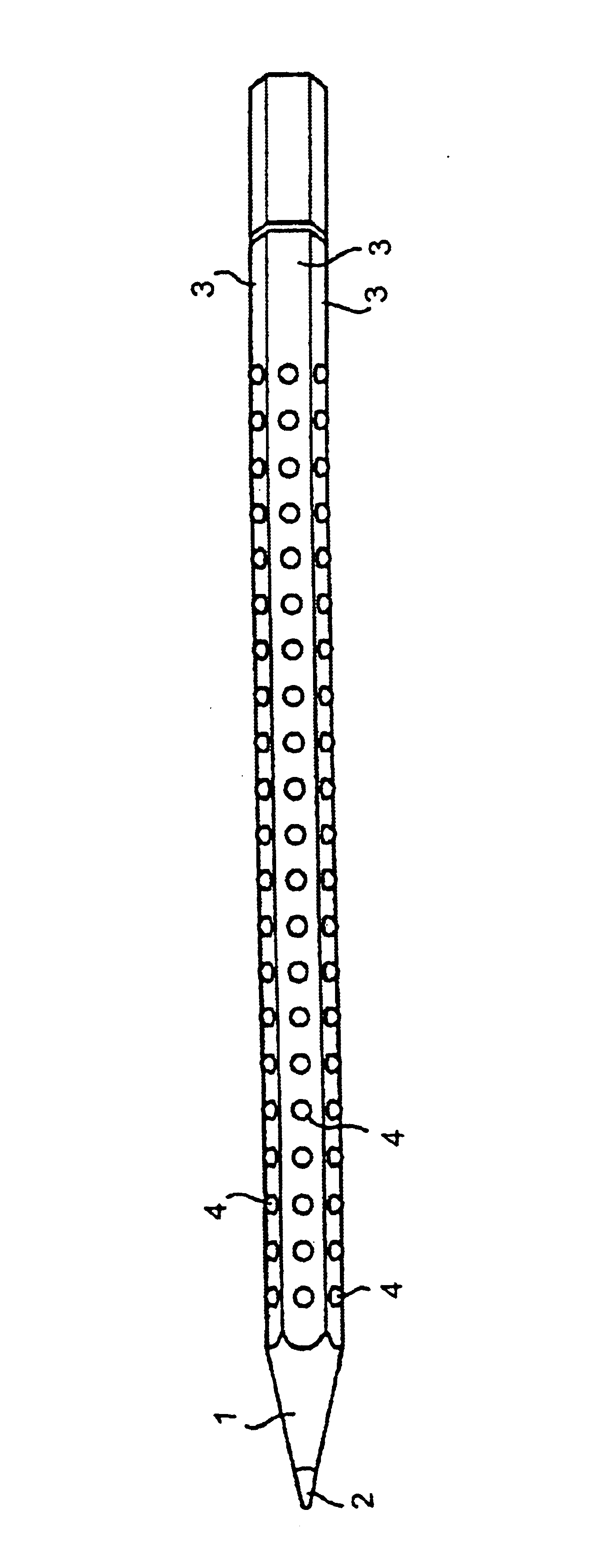Wood-encased pencil for writing, sketching, drawing, and cosmetic purposes
a pencil and wood technology, applied in the field of pencils for writing, sketching, drawing, cosmetic purposes, can solve the problems of fatigue upon extended use, and the nubs known from the cited publication cannot be used for wood-encased pencils, and achieve the effect of increasing the viscosity of the preparation
- Summary
- Abstract
- Description
- Claims
- Application Information
AI Technical Summary
Benefits of technology
Problems solved by technology
Method used
Image
Examples
example 1
A UV crosslinkable system for transparent or colorless surface structures for wood-encased pencils.
Acrylate oligomer (Ebecryl 600 / 35 OT)76.5%Acrylate monomer (Ebecryl 40)8%Benzophenone (photoinitiator)4%Reactive tertiary amine (co-initiator)8%Hydroxycyclohexyl phenyl ketone (co-initiator)1%Flow-control and slip agent1.5%Antifoam1%
The UV curable acrylates Ebecryl 600 / 35 OT and Ebecryl 40 are available from UCB Chemie GmbH, Kerpen, Germany 50170. The tertiary amine used is manufactured, for example, by CIBA Spezialitatenchemie, Lampertheim, Germany 68632. After structures have been applied to wood-encased pencils, crosslinking is achieved by irradiating with UV light. The flow-control and slip agent used is TEGO Glide 440, and the antifoam used is TEGO Airex 900, both products from TEGO Chemie Service GmbH, Essen, Germany 45139.
The application of the preparation to a wood-encased pencil is carried out by screen-printing. Shortly after application of the preparation, the pencil is pass...
example 2
A UV-crosslinkable system, solvent-free, for black colored surface structures.
Polyester acrylate (Laromer LR 9004, BASF)93.6%Pigment preparation (Black 550920 / N50,3.4%Coates Screen Inks)Alpha-hydroxy ketone photoinitiator2.0%(Darocure 1173, Ciba)Acylphosphine oxide photoinitiator1.0%(Lucirin TPO, BASF)
The application to a pencil casing and curing takes place as in example 1.
example 3
Butyl acetate (solvent)45%Methoxypropyl acetate (solvent)15%n-Butyl glycolate (solvent)5%Nitrocellulose (plastic)24%Calcium carbonate (filler)9%Thickener, Aerosil 200, Degussa0.5%Wax additive0.5%Antifoam0.8%Flow-control agent0.2%
Nitrocellulose is available, for example, in the form of chips from Hagedorn AG, Lingen, Germany 49808, under the name H-24, and the wax is available from Lawter International Belgium, N.V. under the name Polysperse E. The antifoam used is the product “No air liquid” prepared by Bärlocher, and the flow-control agent used is Dow Corning 57. The latter is a product of Dow Jones, Wiesbaden, Germany 65201. The preparation is, likewise, applied in a screen-printing process. The pencils are, then, dried to remove the solvent from the raised structures.
PUM
| Property | Measurement | Unit |
|---|---|---|
| temperatures | aaaaa | aaaaa |
| percentage weight | aaaaa | aaaaa |
| force | aaaaa | aaaaa |
Abstract
Description
Claims
Application Information
 Login to View More
Login to View More - R&D
- Intellectual Property
- Life Sciences
- Materials
- Tech Scout
- Unparalleled Data Quality
- Higher Quality Content
- 60% Fewer Hallucinations
Browse by: Latest US Patents, China's latest patents, Technical Efficacy Thesaurus, Application Domain, Technology Topic, Popular Technical Reports.
© 2025 PatSnap. All rights reserved.Legal|Privacy policy|Modern Slavery Act Transparency Statement|Sitemap|About US| Contact US: help@patsnap.com


